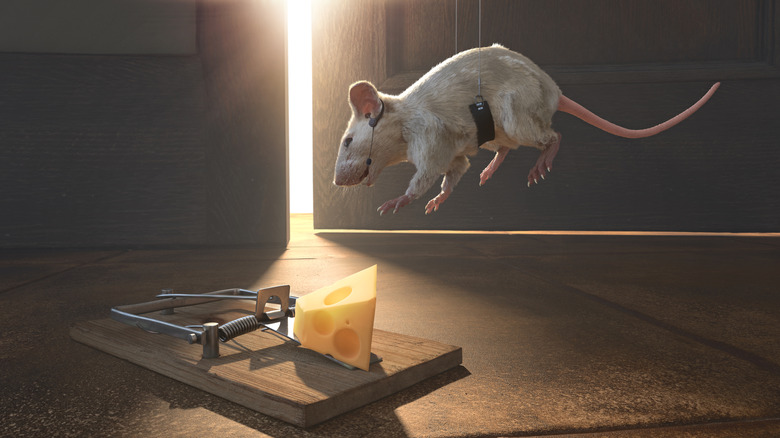If Mice Are Avoiding Your Traps, This Could Be Why
With an excellent sense of smell, a mouse finds food simply by following its nose. They're particularly attracted to fatty and sweet foods, so even candles and soap can attract mice to your home if they smell like those foods. When mice invade your house, though, it can be difficult to get rid of them. Putting out traps is one of the go-to ways to do that, but sometimes it seems as if the mice are spies who know all the right ways to avoid getting caught. In reality, the same sense of smell that attracts them to the foods they love is also its secret weapon against traps.
One way that mice use their sense of smell to avoid traps is by detecting your scent. Since they've been hiding in your house, they know what you (and everyone else in your household) smell like. That means they will avoid any trap that smells like you, so if you don't use gloves while baiting and placing traps, the mice will stay away from them since they are afraid of people. Another way that the smell gives the traps away is if they smell like other dead mice. That's why you should check the traps you've set regularly, and remove any dead mice that have been caught. If you don't feel comfortable cleaning them to eliminate any residual scent, you could set new ones in their place.
The natural behaviors of mice help them avoid traps, too
Avoiding traps has quite a bit to do with the behaviors of mice as well. Mice are social animals that live in communities, and their adaptability means that they can live either outdoors or indoors. But, while they're curious creatures, mice are also more intelligent than you might think. That's why, if you see them running through your house, it's usually with one of their sides against the wall — which is why they often escape so easily. This behavior also allows them to avoid traps that aren't placed in their path.
Another reason mice are able to avoid traps is because they're very cautious, especially while they feed. Since they're on high alert, they're able to bounce away quickly even after triggering a spring trap. And sometimes, they may nibble so lightly at the food on the traps that the trigger never springs into action. As a result, traps can be grouped together to increase the likelihood of at least one of them catching a mouse.
Tips for setting and placing snap traps for mice
Although it's possible for rodents and vermin to avoid spring traps no matter what you do, you can increase your chances of catching them. Start with choosing the right bait, which includes sweet, high-fat, high-protein, and strong-smelling foods. For instance, bacon has a high-fat content and strong smell that entices these creatures, as do some cheeses. Chocolate, on the other hand, has the sweet taste and strong aroma that they go after, while dried fruits also have sweetness as well as a chewy texture. You could even use tree nuts, particularly almonds and hazelnuts, because they're high in protein content and smell strong.
Once you've chosen your "poison," avoid using a large amount. Putting too much bait onto a snap trap makes it too obvious, especially when the mice are being cautious. Instead, place small pea-sized portions in multiple spots. When it comes to placing the traps, one of the biggest mistakes people make is spreading them around. The best places to put them are up against baseboards and walls where the rodents are most likely to walk by. Other good spots include behind appliances, under furniture, in dark corners, and near the nest — which is usually wherever you see chew marks and droppings.
Keep in mind, though, that the placement should be out of reach of kids and pets for safety. And, since it can still take a few days for the mouse traps to work, it's recommended that you monitor and reset them with fresh bait as necessary.


